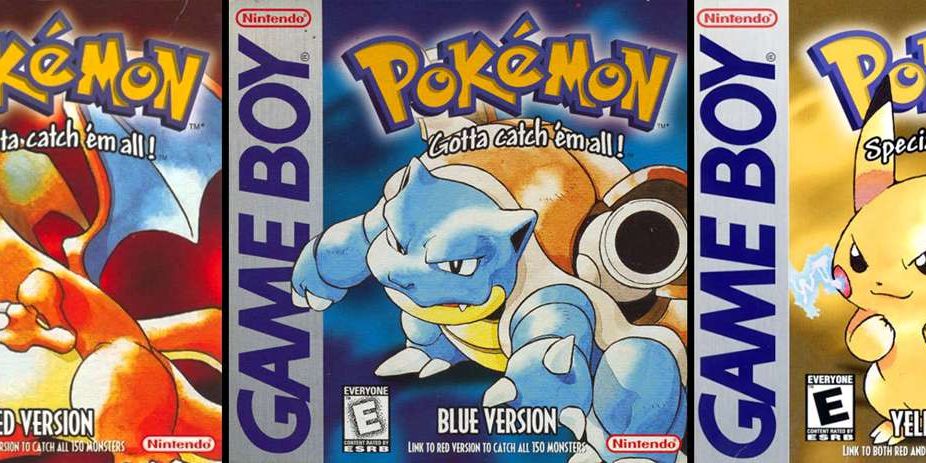Exploring the Legacy of Pokémon Red, Blue, and Yellow: A Nostalgic Journey Through the Original Pokémon Games

Exploring the Legacy of Pokémon Red, Blue, and Yellow: A Nostalgic Journey Through the Original Pokémon Games
The Pokémon franchise, one of the most iconic in the world, began with three revolutionary games: Pokémon Red, Blue, and Yellow for the Game Boy. Released between 1996 and 1998 in different regions, these games laid the foundation for a multi-billion dollar franchise spanning games, trading cards, anime, and more. For many, these games were the entry point to a magical world filled with fantastical creatures, deep strategic battles, and an immersive story that kept players hooked for hours on end.

The Origins and Development of Pokémon Red and Blue
Pokémon Red and Green were first released in Japan in 1996, developed by Game Freak and published by Nintendo. These games, initially created by Satoshi Tajiri and his team at Game Freak, were the realization of Tajiri's childhood dream to create a game where players could interact with nature and capture creatures, inspired by his love for bug collecting. Red and Green became a sensation in Japan, and due to their success, Nintendo decided to release localized versions in the United States and Europe under the titles Pokémon Red and Blue, which were released in 1998.
The game's development was groundbreaking for its time. Game Freak worked with the limitations of the Game Boy, innovating with compressed data to fit all 151 Pokémon onto the tiny cartridges. Creatures, their moves, and interactions were carefully programmed to create a world that felt alive despite the technical constraints. The goal was to create an experience where each player felt like a true Pokémon Trainer, discovering the world and making their own unique path to success.
Gameplay Mechanics and Objectives
At its core, Pokémon Red and Blue focused on two main objectives: completing the Pokédex by capturing all 151 Pokémon and defeating the Elite Four to become the Champion. Players took on the role of a young Trainer from Pallet Town who receives a starter Pokémon from Professor Oak. From there, players travel across Kanto, battling wild Pokémon, challenging eight Gym Leaders, and confronting the villainous Team Rocket.
The gameplay was structured around exploration, battles, and strategy. Players could encounter wild Pokémon in various locations, each with unique types, moves, and strengths. Capturing Pokémon required skill, as players had to weaken creatures in battle before using Poké Balls to capture them. The unique mechanics of leveling up and evolving Pokémon added depth, with each species evolving in different ways – through leveling up, using evolutionary stones, or trading with other players.
The concept of type advantages – where certain Pokémon types are strong or weak against others – was another strategic layer that encouraged players to diversify their teams. For example, a Water-type Pokémon would have an advantage over a Fire-type, while a Grass-type would be weak against Fire-type moves. This added complexity made battles challenging and engaging, pushing players to think critically about their team composition and tactics.
The Impact of Pokémon Trading and Multiplayer
One of the most revolutionary features of Pokémon Red and Blue was the multiplayer element, introduced through trading and battling via the Game Boy Link Cable. This feature encouraged players to interact with others, exchanging Pokémon and completing their Pokédex. Certain Pokémon, like Machamp and Gengar, could only be obtained by trading, which added an extra layer of social interaction to the game.
The multiplayer battles also allowed friends to test their teams against each other, showcasing their Pokémon and strategies. This feature was essential to the game's social aspect, building a community around Pokémon that extended beyond the screen. Trading and battling fostered collaboration and competition, making Pokémon a shared experience among friends.
Introduction of Pokémon Yellow: Special Pikachu Edition
Pokémon Yellow: Special Pikachu Edition was released in 1998 in Japan and 1999 worldwide as an enhanced version of Red and Blue. Drawing inspiration from the popularity of the Pokémon animated series, Yellow gave players a Pikachu as their starter Pokémon, mirroring Ash Ketchum's experience in the show. Unlike in Red and Blue, this Pikachu followed the player on-screen, responding with different expressions based on its happiness level. This feature created a deeper bond between the player and their Pikachu, adding a new level of emotional investment.
Pokémon Yellow also introduced minor graphical improvements and tweaks to certain battles, aligning more closely with the anime’s storyline. For instance, players could encounter Team Rocket's Jessie and James, who appeared in the anime as comic-relief villains. Yellow was designed to appeal to fans of the TV series, creating a more cohesive experience between the show and the games.
Exploring the Kanto Region
The Kanto region, where Pokémon Red, Blue, and Yellow are set, became an iconic map in gaming history. With locations like Viridian Forest, Mt. Moon, and Cinnabar Island, Kanto felt vast and immersive despite the limited technology of the Game Boy. Each town and city had a unique atmosphere, and players met interesting characters and discovered hidden items that enriched the experience. The Safari Zone, a special area where players could capture rare Pokémon using unique mechanics, was a particular highlight, adding to the sense of adventure and wonder.
The structure of Kanto encouraged exploration and discovery. There were hidden caves, side quests, and secret items that rewarded curious players. Many trainers fondly remember searching for the elusive Mewtwo in the Cerulean Cave or attempting to catch rare Pokémon like Dratini in the Safari Zone.
Legacy of Pokémon Red, Blue, and Yellow
The impact of Pokémon Red, Blue, and Yellow on the gaming world is immeasurable. These games were among the best-selling Game Boy titles of all time, helping to propel the Pokémon franchise into a global phenomenon. They introduced millions of players to the world of Pokémon, establishing a foundation that the series would continue to build upon for decades.
In terms of game design, Red, Blue, and Yellow demonstrated the power of simple mechanics combined with deep strategic possibilities. The concept of catching, training, and battling Pokémon has remained central to the series, even as the games have evolved to include new generations, mechanics, and regions.
The games’ influence extends beyond gaming. The Pokémon franchise became a cultural phenomenon, with trading cards, merchandise, a long-running anime series, and even feature films. Pokémon Red, Blue, and Yellow established a legacy that would inspire not only sequels and spinoffs but also an entire genre of monster-catching games.
Enduring Popularity and Modern Revivals
Despite the advancements in graphics and gameplay in later Pokémon games, Red, Blue, and Yellow retain a special place in fans' hearts. Their nostalgic charm and straightforward mechanics appeal to both newcomers and veterans of the series. In 2016, Pokémon Red, Blue, and Yellow were re-released on the Nintendo 3DS Virtual Console, allowing a new generation of players to experience the games that started it all.
The success of Pokémon: Let’s Go, Pikachu! and Let’s Go, Eevee! for the Nintendo Switch in 2018 further underscored the enduring appeal of the original games. These titles reimagined Yellow with modern graphics and mechanics, blending nostalgia with new gameplay experiences.
Conclusion: The Timeless Charm of Pokémon Red, Blue, and Yellow
Pokémon Red, Blue, and Yellow represent more than just video games; they are a cultural touchstone, a shared memory among millions of fans worldwide. These games introduced players to a world where they could forge their own path, catch and train creatures, and engage in battles that felt meaningful and strategic. Their legacy lives on in the hearts of fans and in the many Pokémon games that followed.
As we look back on these games, it's clear that their influence on the gaming industry and popular culture is still felt today. Whether it’s through the modern games inspired by the originals or the cherished memories of players who first ventured into Kanto decades ago, Pokémon Red, Blue, and Yellow remain timeless classics that will forever be a part of gaming history.